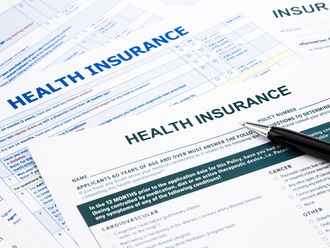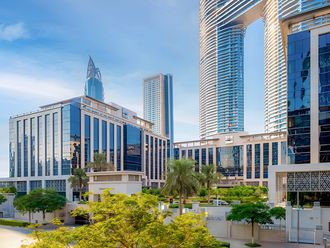
Dubai: RAKBank, the Abu Dhabi listed lender predominately focused on retail and small and medium enterprises (SME) business expects to see healthy asset and revenue growth and improved profitability in 2015, Peter England, CEO of the bank told Gulf News in an interview.
The bank reported Dh1.45 billion net profit for the year 2014 with the operating profit before provisions up by 15.7 per cent from the previous year. Total assets grew by 15.6 per cent to Dh34.8 billion compared to Dh30.12 billion at the year-end 2013. Bank’s total operating income went up by 13 per cent or Dh404.8 million to Dh3.56 billion as net interest income and net income from Islamic financing grew by 11.8 per cent to Dh2.76 billion.
“Overall I am very pleased with the 2015 numbers. Our topline has grown very strongly while our cost base has not increased much, our cost to income ratio has declined, so overall we are very comfortable with our operating income,” said England.
The bank’s year on year net profit growth in 2014 was small as a result higher provisions. However England said he views the current level of provisions “neither too high nor too low”.
Most banks in the UAE are large corporate lenders. Corporate banks in general do well when times are good as the bad debts are relatively low. But return on large corporate loans is relatively low compared to retail loans and unsecured business loans which carry high returns and relatively higher risk resulting in higher bad debt levels.
“When looked at from the context of the high level of returns we generate, we should also expect a relatively high level of bad debt. In bad times banks like ours are likely to perform better compared to large corporate lenders,” said England.
Leaving aside the bottom line numbers, the bank’s results last year were very strong. “Our return on average equity is 22 per cent that is far higher than any other bank in this country. Our tier 1 capital is 26.5 per cent one of the highest in the country. At the current level of bad debts our returns are far superior to most banks in the UAE,” said RAKBank CEO.
At the year end 2014 the bank’s net interest margins were 8.3 per cent while return on average assets was at 4.4 per cent. “Globally most banks would struggle to achieve 2 per cent return on average assets. So in the current context RAKBank is relatively unique in this market and our performance has been superior to our peers,” said England.
RAKBank’s non-interest income was up by Dh113.1 million as net fees and commission income was bolstered by strong performances in the income streams of credit cards, RAKFinance, (the unsecured lending to small businesses), and business banking, in addition to trade finance solutions.
The bank expects the non-interest income to grow in 2015. There were three things that drove non-interest income in 2014. First was the loan growth, along with this the fee income related to that activity grew, the second was from trade finance, as the bank grew in asset size in this segment the fee income and forex income grew. In all these segments the bank expects to see the growth to continue.
RAKBank’s CEO expects NPLs to remain pretty low at 2.3 to 2.4 per cent of the loan book next year. But in the unsecured lending the bank tends to write off the bad debts very fast. Thus a more accurate number to assess the asset quality would be the net credit loss positions.
“In 2014 our net credit loss position was about 2.5 per cent, in 2015 we expect it to be marginally higher simply because the areas we are operating are those with higher return and higher risks. But about 2.5 per cent to 3 per cent is acceptable for the level of returns,” said England.
On the funding front the bank has $500 million EMTN [euro medium term note] programme which it launched it last year. “We can go back and top up that programme to $1 billion without much hassle. We may look at doing that sometime during the year depending on the loan growth and the deposits growth coming in,” said England.












